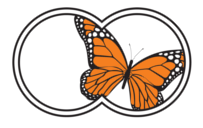MonarchNet's featured scientists are some of the most dedicated and productive scientists and citizen-scientists who collect and/or analyze monarch monitoring data, in any of our partnering programs.
Featured Scientists
Current Featured Scientist
Doug Taron, Director of Illinois Butterfly Monitoring Project

Doug Taron grew up in New England where he received his first butterfly net from the Easter Bunny at age 7. Doug moved to the Midwest to study biochemistry and molecular biology, earning a doctorate from Northwestern University in 1984. While at Northwestern, he became active as a volunteer at Bluff Spring Fen in northeastern Illinois, and then the vibrant stewardship community of the Chicago area. While spending a dozen years working in the biotechnology industry, Taron became involved in The Illinois Butterfly Monitoring Network (IBMN), a group founded by The Nature Conservancy to try to help them gauge the effects of ecological restoration on butterflies. He became director of that program in 1989. In 1997, Doug was approached by the Chicago Academy of Sciences as they were building the Peggy Notebaert Nature Museum and seeking somebody to help build and run a proposed butterfly vivarium. He joined the team, bringing the monitoring network with him and initiating a research program in butterfly conservation. The professional connections that resulted from his new job allowed him to introduce the IBMN to others around the country, and new networks emerged in several other states. Doug has published several papers using IBMN data, including a key recent paper on monarch population dynamics. Doug is now a co-director of the North American Butterfly Monitoring Network and is a primary resource for helping new groups start their own butterfly monitoring network and has also been working with European colleagues to help spread butterfly monitoring worldwide.
Past Featured Scientists
Denny Brooks, a dedicated Citizen-Scientist from Midland, MI
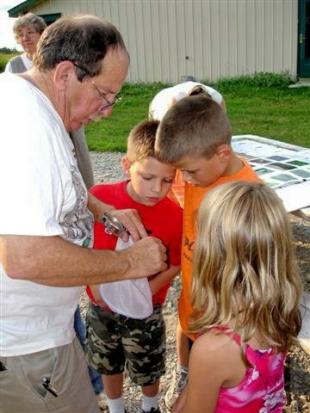
Denny Brooks is from Midland, MI and has studied and photographed nature for over 45 years. In 1990 he started studying butterflies in general and in 2000, he started focusing on monarch butterflies. He has been going strong ever since, participating in multiple citizen-science projects.
As he tracks the returning monarchs from the south, in the late spring and early summer months, he starts his various projects. He says he spends as much if not more time surveying milkweed for caterpillars and eggs as he does with the adult butterflies! In the summer he does weekly surveys for the Monarch Larva Monitoring Project (MLMP) at a site on the Chippewa Nature Center, looking for Monarch eggs, caterpillars and active adults. During this time he also nets, measures, weighs, and does parasite testing on adult monarchs for MonarchHealth. In late August as the freshly emerged monarchs are heading for Mexico, he starts tagging butterflies for MonarchWatch.
Denny's decidation to these various projects recently led to a feature newspaper article about him in the Midland Daily News. See the article here.
Thanks Denny, for your monarch conservation efforts!
Dick Walton, Coordinator of the Cape May Monarch Monitoring Project

Dick Walton is one of the most famous citizen-scientists around. He spearheads the longest-running monarch migration census program in North America, the Monarch Monitoring Project at Cape May, New Jersey. The Cape May Monitoring Project is one of several seasonal programs affiliated with New Jersey Audubon's Cape May Bird Observatory. It was established by Dick and Dr. Lincoln Brower in 1992, and now represents one of the best sources of information on the status of monarch populations in existence. The greatest strength of this data set is its consistency - each fall, like clockwork, Dick and his monarch team (see below) conduct daily censuses around the same route, which takes the same amount of time, and which is conducted three times daily in September and October. This is done rain or shine, even if there are no monarchs to be seen anywhere! Thus, with these data, scientists can learn a great deal about not only how many monarchs there are each year in this area of the country, but also aspects of their migration biology that add to the collective knowledge of this butterfly. In fact, Dick is a coauthor on several scientific publications where these data were analysed by scientists.
Dick should also be commended for assembling a crakerjack team of dedicated monarch people who contribute to the censuses, tagging and demonstrations that take place at the Cape May Hawkwatch area during the fall. These folks include: Louise Zemaitis (field coordinator), Dr. Lincoln Brower (scientific advisor), David Mizrahi (vice-president for research, NJA), and Don Freiday (director of birding programs, CMBO).
Above all, it is thanks to Dick's dedication and stick-to-it-ness, that this data set exists. We at MonarchNet thank Dick for his efforts, and look forward to working with him much more in the future! Congrats, Dick for being our latest scientist of the month!
Sonia Altizer, Associate Professor at the University of Georgia
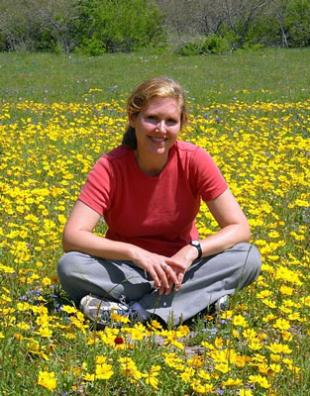
Sonia had the honor of being the first Scientist-of-the-Month for MonarchNet.
Sonia has been studying monarchs for 15 years, and has been focusing much of her time on studying the interactions between the parasite Ophryocystis elektroscirrha (OE) and their host, monarch butterflies. She is the leader of the Monarch Health program (see details at www.monarchparasites.org), and she is one of the founding members of MonarchNet.
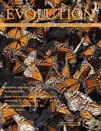 This month, a scientific paper written by Sonia and her husband, Andy Davis, that described morphological variation in wing features of monarch populations, was published in the highly-prestigious journal, Evolution, and the issue even featured monarchs on the cover. Congratulations Sonia (and Andy)!
This month, a scientific paper written by Sonia and her husband, Andy Davis, that described morphological variation in wing features of monarch populations, was published in the highly-prestigious journal, Evolution, and the issue even featured monarchs on the cover. Congratulations Sonia (and Andy)!
Dr. Becky Bartel, postdoctoral researcher at the University of Georgia
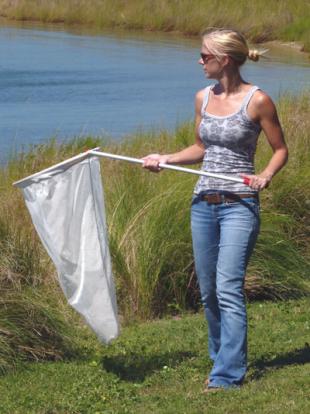
Dr. Bartel is a newby in the world of monarch research, but already has been making some great contributions to our knowledge of this amazing insect, and for this, she deserves recognition as our latest scientist of the month.
Since 2008, she has worked with multiple collaborators to investigate different aspects of how the seasonal migrations of monarch butterflies affect the spread of the parasite, Ophryocystis elektroscirrha (Oe). Most recently, results of some of this work were published in the journal Ecology and featured as the cover story. Together with Sonia Altizer, Jaap De Roode, Karen Oberhauser, this research combined field-sampling and analysis of citizen science data (MonarchHealth, Monarch Larval Monitoring Project) to examine trends in rates of parasite infection across the eastern North American migratory monarch populations. One of the main findings with this project was that the number of infected monarchs increases from early- to late-summer each year throughout its range, probably because the Oe spores build up over time on milkweed leaves.
This was a great study that demonstrated how scientists and citizen-scientists can combine forces to learn more about monarch biology, which will ultimately help in conservation efforts. The study is now available in the online early section of the journal Ecology.
Great job, Becky!
Gina Badgett, Volunteer Coordinator for the Peninsula Pt. Migration Project
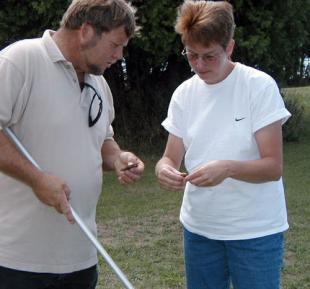
Gina Badgett is a volunteer coordinator extraordinaire! Gina has been the Volunteer Coordinator for the Monarch Migration Census and tagging program portion of the Monarch Research Program (MRP) at Peninsula Point over the past 8 years. Gina has tirelessly volunteered over 735 hours to this project! Gina took over the coordination of this part of the study after 10-year volunteer and program catalyst C.J. Meitner retired in 2003.
Gina’s family has also assisted with the migration monitoring and tagging over the years. Gina along with volunteers involved in other aspects of the MRP received the prestigious 'Wings Across the Americas Award' in the Butterfly Conservation Category in 2008. Gina received this award for her dedication to the monarch Research Program on the Hiawatha National Forest. The tagging Gina has conducted has assisted researchers in knowing where monarchs migrate. Gina has tagged over 3,500 butterflies. More than twenty of these tags have been recovered from El Rosario and Sierra Chincua Mexico.
Gina and the Peninsula Point monitoring site were featured in the German documentary “Highway of Butterflies” which played on PBS stations across the country. Gina also supports the Monarch Research Program on the Hiawatha by selling used books at her store to raise money for the project to supplement the yearly grant received by Wildlife Unlimited of Delta County.
Thanks to the efforts of volunteers like Gina, the data collected at Peninsula Point has enhanced scientific understanding of monarch migration. In 2004 in the journal Environmental Entomology published the paper 'Migration Patterns and Environmental Effects on Stopover of Monarch Butterfly (Lepidoptera, Nymphalidae) at Peninsula Point, Michigan' by authors C. J. Meitner, Lincoln Brower and Andrew Davis.
Thanks Gina, for your monarch conservation efforts!
Larry Brindza, from the Coastal Virginia Wildlife Observatory
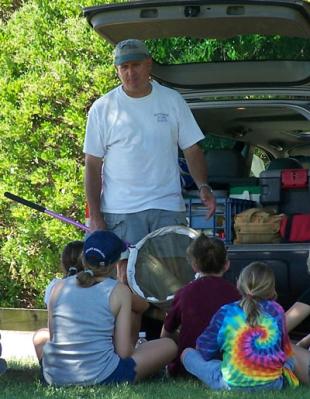
Larry takes monarch tagging to the next level. He serves as the coordinator of the Monarch Migration Project at the Coastal Virginia Wildlife Observatory, which is located at the southern tip of the Delmarva Penninsula, an area known for its spectacular fall monarch concentrations.
Larry's journey to this point began 15 years ago in the days of rectangular-paper tags and rubber cement. In October of 2000 he started helping Mark Garland and Andy Davis tag monarchs at Kiptopeke State Park, and he later took over the reigns as coordinator of this annual effort.
In 2002 he added another dimension to his tagging by weighing all captured monarchs with a small electronic scale. He also measures forewing lengths with digital calipers and monitors for Ophryocystis electroscirrha (Oe). This extra effort by him to collect such detailed data on each tagged monarch is something that few other taggers do, but in the end is extremely valuable to science. Because of this, in 2008 he collaborated with Dr. Lincoln Brower and Dr. Andy Davis to publish a major article in the Journal of the Lepidopterists’ Society using his monarch data set.
In 2002 Larry also added a another monarch study site in an inland location. Occoquan Bay National Wildlife Refuge (OBNWR) in Prince William County in Northern Virginia is 20 miles south of Washington DC at the confluence of the Potomac and Occoquan Rivers. There are several hundreds of native grass meadows, which provide rich nectar sources for the monarch migration.
Over the years Larry has given many presentations on monarch biology and the phenomenon of the monarch migration to refuge and state park visiting groups, conservation groups, and such diverse audiences as the Williamsburg Botanical Garden to an annual kindergarten class.
Larry's exemplary monarch tagging efforts make him well-suited to the scientist of the month club. Everone who tags monarchs should follow in his lead!
Kip Kiphart, Citizen-scientist from Bergheim, Texas
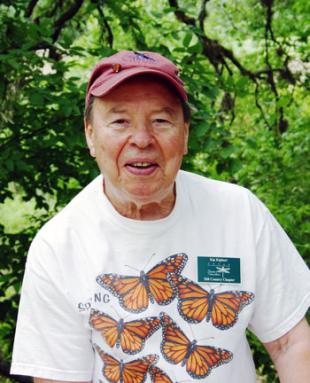
As a retired cardio-vascular surgeon turned Texas Master Naturalist, Dr. Ridlon (Kip) Kiphart found his passion for monarch butterflies through a rather indirect route. His son, working for a native plant nursery in Texas in the early 1990’s, introduced several plants to Kip’s front yard in Dallas, and not only did Kip get hooked on the native foliage, but he also admired the butterflies that came to nectar. Captivated, he quickly set out to learn the differences among monarchs, viceroys and queens, and taking pictures. Following training as a Texas Master naturalist in 1998, he gradually immersed himself in butterfly biology and ecology, and butterfly gardening.
Through his volunteer work at Cibolo Nature Center in Boerne, Kip was introduced to the Monarch Larva Monitoring Program in 2002 by Monarch Larva Monitoring Project volunteer Mary Kennedy. After monitoring eggs and larvae that year, he officially became an MLMP Trainer at a workshop conducted at Bamberger Ranch in Texas. He has subsequently conducted dozens of other workshops for volunteers from CNC and Master Naturalists throughout Texas, including the popular semi-annual "MLMP @ CNC" Back Porch Review and the TMN annual meeting. Kip is a presenter at the Texas Monarch Monitoring Project semi-annual workshop. Many of the dots on the Texas MLMP map are the direct result of Kip’s powers of persuasion and enthusiasm.
In 2008 he received the Presidential Volunteer Service Award from the President’s Council on Service and Participation for volunteering 5000 hours for the TMN program. Kip has also continued to monitor monarchs every year since 2002, both at home in suburban Bergheim and at the Cibolo Nature Center. Finally, he is involved in a variety of other Wildlife Field Research projects, both as a participant and official photographer.
Eduardo Rendón Salinas, Monarch Program Coordinator, World Wildlife Fund, Mexico
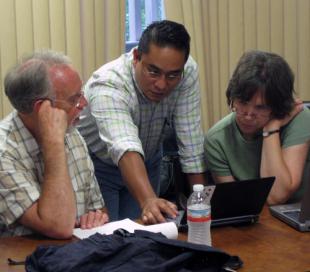
Eduardo Rendón Salinas is in charge of the monarch butterfly monitoring program at WWF-Mexico, which is the organization that spearheads the annual assessment of overwintering colony sizes at the 12+ wintering sites in central Mexico. His tireless efforts at this post deserve our recognition as the latest scientist of the month.
Because the vast majority of the monarchs in the eastern North American population winters at these same sites, the measurement of colony sizes provides information that is crucial to understanding the dynamics of the life cycle of this insect, as well as for assessing the population status of 'eastern' monarchs. Each year, the reports of colony sizes from Eduardo and his staff are eagerly anticipated by monarch researchers and concerned citizens, especially when the population is low.
Eduardo is also to be commended for his colleagiality and frequent participation in meetings of monarch scientists from the United States and Canada. In fact, Eduardo participated in the 2009 meeting of scientists in Georgia that led to the founding of MonarchNet!
Keep up the good work, Eduardo!
Don Davis, Legendary Monarch Tagger from Toronto, Ontario Canada
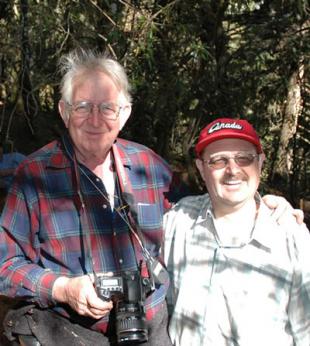
Don Davis works in the field of Child Welfare in Toronto but for decades has contributed to many monarch-related projects as a “Citizen Scientist”, starting in 1968 as one of the Urquhart’s volunteer “Research Associates”. He has watched the interest and passion for monarch research and conservation mushroom from a few weeks of tagging in the fall to a year-round multi-national effort involving many talented and dedicated individuals and organizations.
Taking a break in the 1970’s, Don reconnected with the Urquharts and has continued this work since 1985. The Urquharts ended their program in 1992 and with tags no longer available, Don had his own manufactured. The recovery of these tags in Mexico led to making connections with Monarch Watch and David Marriott of the Monarch Program in California. One Elizabeth “Donnelly” later called about her new program called “Journey North”! Aside from tagging tens of thousands of monarchs, with perhaps a couple of hundred recoveries, primarily from the Mexican overwintering sites, Don has had the opportunity to travel to many monarch-related conferences and conventions, including the 1997 International Conference in Morelia, and the various meetings and workshops that lead to the development of the North American Monarch Butterfly Conservation Plan. Don served on the Board of Directors of the Michoacan Reforestation Fund (now the Monarch Butterfly Fund); assisted and appeared in a number of monarch documentaries; supported and reviewed the writing of a number of books; has spoken to various groups in Ontario and Quebec, and also in California and Mexico.
Don feels that it is particularly important to develop in children a knowledge and interest in the outdoors and nature, and he often speaks to school and nature groups.
Don feels fortunate to have known some of the early movers and shakers in the world of monarchs – the Urquharts, the Bruggers, Lincoln Brower and others – while also watching new generations of scientists and citizen scientists make new discoveries. Don still receives Michigan monarch reports from one of the Urquhart's first taggers who responded to a call for help in a 1952 Natural History magazine article. This lady is now 98 years of age!
Don is still recognized by the Guinness Book of Records for recording the Longest Migration by a Butterfly - a record no longer published in the book. This was a monarch he released in Ontario in September 1987 and was recovered alive in Austin, Texas in April 1988. - Great job, Don!
Harlen and Altus Aschen, from Port Lavaca, TX
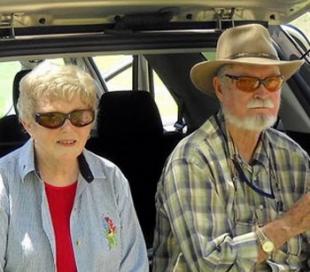
Harlen and Altus Aschen are two very dedicated monarch-watchers, and are highly committed to the conservation of this insect. They are regulars on the monarch listserves and email reports, aways keeping people in cyberspace up-to-date on the status of monarchs in their corner of Texas. Harlen is also a frequent reporter to Journey North, during all times of the year, contibuting notes on monarch migration through the area in the spring and fall, breeding numbers, as well as numbers of monarchs that overwinter in this part of Texas.
It was Harlen's frequent sightings of overwintering monarchs in Texas that led to a recent scientific paper being written on the topic where he was included as an author!
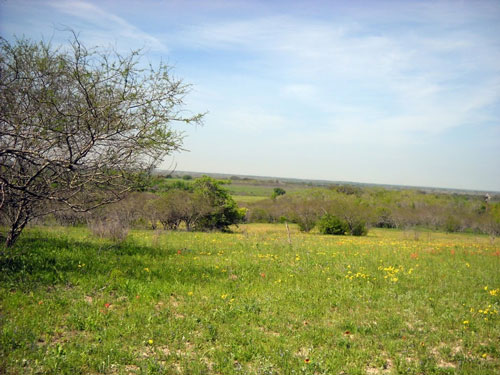 The Aschens are also famous in the world of monarchs for their incredible 'farm' in southern Texas, where there are fields and fields of native milkweeds (Antelope horn milkweed, and others) that are hosts to monarchs returning northward in the spring, and where many monarch researchers have visited to make collections for research projects.
The Aschens are also famous in the world of monarchs for their incredible 'farm' in southern Texas, where there are fields and fields of native milkweeds (Antelope horn milkweed, and others) that are hosts to monarchs returning northward in the spring, and where many monarch researchers have visited to make collections for research projects.
Harlen and Altus have also become local experts on native milkweeds, and even have their own website devoted to the topic - http://www.asclepias.org/
Keep up the good work, Harlen and Altus!
